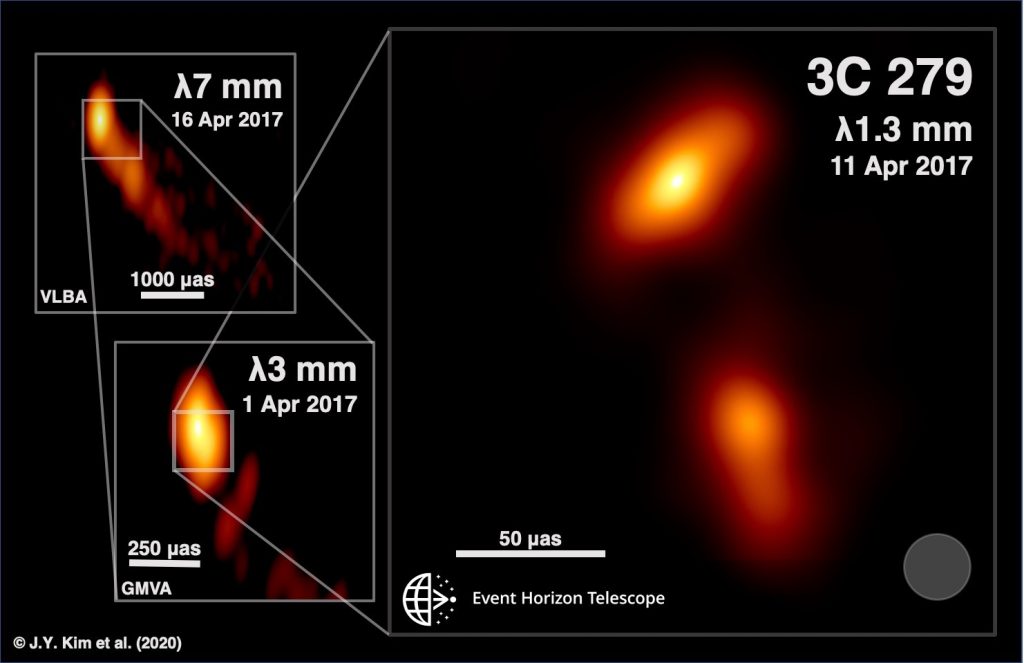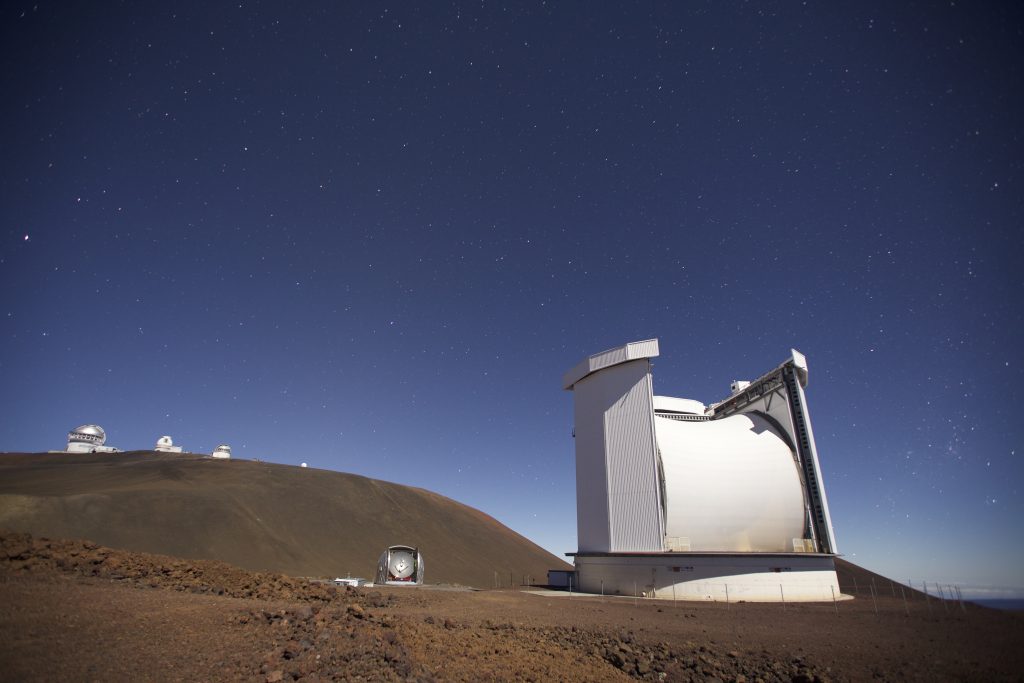First Event Horizon Telescope Observations of a Black-Hole Powered Jet announced as Maunakea Observatories offer MKO@Home online resources
Two Hawai’i-based telescopes, the James Clerk Maxwell Telescope (JCMT), operated by the East Asian Observatory, and the Submillimeter Array (SMA), operated by the Smithsonian Astrophysical Observatory and the Academia Sinica Institute for Astronomy and Astrophysics, have once again provided crucial information in the global effort to understand Black Holes. The JCMT and SMA linked up with six other telescopes around the world to form the Event Horizon Telescope (EHT), in an effort involving hundreds of astronomers and engineers. The black hole targeted in these observations resides at the centre of a galaxy called 3C 279. This galaxy is 5 billion light years away in the direction of the Virgo constellation.
Nearly one year ago, the JCMT and the SMA played a vital role in the groundbreaking EHT observational campaign to observe the very first image of a black hole, which was given the Hawaiian name Pōwehi. The EHT collaboration is excited to announce this new result from data obtained at the same time as the Pōwehi result.
For the first time, astronomers have observed a jet travelling at close to the speed of light, that is believed to originate from the vicinity of a supermassive black hole, in unprecedented detail. In their analysis, led by astronomer Jae-Young Kim from the Max Planck Institute for Radio Astronomy in Bonn (MPIfR), the collaboration studied the exquisite detail of the jet’s shape close to the base. The jet base is a fascinating region where highly variable, high energy gamma-ray emission is thought to originate.
The results will be published in the coming issue of the prestigious journal Astronomy & Astrophysics.

Fig. 1: Illustration of 3C 279 jet structure in April 2017. The observing epochs, arrays, and frequencies are noted at the top of each panel. Credit: J.Y. Kim (MPIfR) & the Event Horizon Telescope Collaboration
The black hole targeted in these observations is called 3C 279. It resides at the centre of a galaxy 5 billion light years away in the direction of the constellation Virgo. Scientists classify this galaxy as a quasar because it shines ultra-bright and flickers, signifying that massive amounts of gases and stars are falling into the giant black hole at the centre. The black hole in 3C 279 is about one billion times the mass of our own sun. Any material such as stars, gas, or dust that comes close to this black hole is shredded by strong gravitational forces, causing a large donut-shaped structure known as an accretion disc to form around the object. But not all of this shredded material stays in the accretion disc or ends up falling into the Super Massive Black Hole. Some of the material will be squirted back out into space in two fine fire-hose-like jets of plasma, travelling at speeds near the speed of light. These jets are powerful and demonstrate the enormous forces at play in the centre of this galaxy.
Through linking up many telescopes across the globe, using a technique known as very long baseline interferometry (VLBI), the astronomers are able to see the jet and accretion disc in action, distinguishing the sharpest-ever details in the jet. The new jet images, probing size scales finer than a light-year, show an unexpected twisted shape at its base, and features perpendicular to the jet, which could represent the poles of the accretion disc from where jets are ejected. Through comparing the images of 3C 279 over subsequent days, the astronomers see the finest details changing, opening up the possibility that we are actually seeing both the rotation of the accretion disc (with the shredding and infall of material), and the jet ejection, that has previously only been modeled in computer simulations of these objects.
Jae-Young Kim, leader of the analysis, is enthusiastic and at the same time puzzled: “We knew that every time you open a new window to the Universe you can find something new. Here, where we expected to find the region where the jet forms by going to the sharpest image possible, we find a kind of perpendicular structure. This is like finding a very different shape by opening the smallest Matryoshka doll.” Furthermore, the fact that the images change so fast has also surprised astronomers. “These jets show apparent motions faster than the speed of light (called superluminal motion), as an optical illusion, but this, perpendicular to the expectation, is new and requires careful analysis”, adds Jae-Young-Kim.
The interpretation of these observations is challenging. In particular, observing apparent motions of about 20 times the speed of light in the jet are difficult to reconcile with the early understanding of the source. These results paint a complex picture, where disturbances in the flow of material, known as shocks, are travelling down a bent (and possibly rotating) jet, and producing incredibly high energy gamma-rays.
“To announce this incredible result exactly a year after we brought Pōwehi to the world makes it so special,” offers Jessica Dempsey, Deputy Director of the James Clerk Maxwell Telescope – one of the two Hawaii-based observatories that are part of the EHT. “For our staff here in Hawaii, it is a reminder of the ground-breaking work they continue to contribute to – even if we aren’t up at the summit right now. Like Pōwehi before it, this beautiful image of 3C 279 gives me hope, for us and for our future.”

Fig. 2: The James Clerk Maxwell Telescope (JCMT) located on the slopes of Maunakea, Hawai`i is pictured in the foreground. The JCMT is operated by the East Asian Observatory. Credit: Will Montgomerie
Anton Zensus, Director at the MPIfR and Chair of the EHT Collaboration Board, stresses the achievement as a global effort: “Last year we could present the first image of the shadow of a black hole. Now we see unexpected changes in the shape of the jet in 3C 279, and we are not done yet. We are working on the analysis of data from the centre of our Galaxy in Sgr A*, and on other active galaxies such as Centaurus A, OJ 287, and NGC 1052. As we told last year: this is just the beginning.”
The March/April 2020 observing campaign of the EHT was cancelled due to the CoViD-19 global outbreak. The EHT Collaboration is now determined on the next steps to follow both in new observations and in the analysis of existing data. Geoff Bower, EHT Project Scientist based at the SMA facility in Hilo concludes: “This is a small piece of good news during this challenging time. We’re very happy to share with the world results from telescopes on Maunakea and around the globe the insights that we have made into black holes, the most exotic objects in the Universe. Both the SMA and the JCMT produced essential data to make these spectacular images, just as they did for Pōwehi. Stay tuned for new discoveries in the year still to come!”
Here in Hawaii, the state’s effort to “flatten the curve” in the fight against CoViD-19 means that many families now have children – keiki – distance learning at home. Together the Maunakea Observatories are supporting our community by providing online STEM resources for schools, teachers and families. The MKO@Home initiative was launched on March 23rd providing educational videos each Monday, Wednesday and Friday. Topics covered include careers, the solar system, recent discoveries, arts and crafts and more. This week MKO@Home will offer a range of activities and lessons involving Black Holes with a culminating event on April 10th, the State of Hawaiʻi’s Pōwehi Day. Four astronomy professionals will host a live panel discussion at 1:00pm HST answering viewers’ questions on all things astronomy and Black Hole related.
Further Information (Links):
Event Horizon Telescope
http://www.eventhorizontelescope.org/
First Image of a black hole, Poōwehi, obtained by the EHT (April 2019)
https://www.eaobservatory.org/jcmt/2019/04/powehi/
James Clerk Maxwell Telescope
https://www.eaobservatory.org/jcmt/
Pōwehi Day proclamation
Governor Ige declares April 10th – Pōwehi Day
MKO@Home on YouTube
http://bit.ly/mkoathome
Background Information:
The international collaboration announced the first-ever image of a black hole, Pōwehi, by creating a virtual Earth-sized telescope at the heart of the radio galaxy Messier 87 on April 10, 2019. Supported by considerable international investment, the EHT links existing telescopes using novel systems — creating a new instrument with the highest angular resolving power that has yet been achieved.
The individual telescopes involved in the EHT collaboration are at present: the James Clerk Maxwell Telescope (JCMT), the Submillimeter Array (SMA), ALMA, APEX, the IRAM 30-meter Telescope, the IRAM NOEMA Observatory (expected 2021), the Kitt Peak Telescope (expected 2021), , the Large Millimeter Telescope (LMT),, the Submillimeter Telescope (SMT), the South Pole Telescope (SPT), and the Greenland Telescope (GLT, since 2018).
The telescopes work together through a VLBI technique. This synchronises facilities around the world and exploits the rotation of our planet to form one huge, Earth-size telescope. VLBI allows the EHT to achieve a resolution of 20 micro-arcseconds — equivalent to identifying an orange on Earth as seen by an astronaut from the Moon. The data analysis to transform raw data to an image required specific computers (or correlators), hosted by the MPIfR in Bonn and the MIT Haystack Observatory.
The EHT consortium consists of 13 stakeholder institutes; the Academia Sinica Institute of Astronomy and Astrophysics, the University of Arizona, the University of Chicago, the East Asian Observatory, Goethe-Universität Frankfurt, Institut de Radioastronomie Millimétrique, Large Millimeter Telescope, Max-Planck-Institut für Radioastronomie, MIT Haystack Observatory, National Astronomical Observatory of Japan, Perimeter Institute for Theoretical Physics, Radboud University and the Smithsonian Astrophysical Observatory.
Original Paper:
J.Y. Kim, T.P. Krichbaum, A.E. Broderick, et al.: Event Horizon Telescope imaging of the archetypal blazar 3C 279 at an extreme 20 microarcsecond resolution, in: Astronomy & Astrophysics, April 2020
https://doi.org/10.1051/0004-6361/202037493
Contact:
Dr. Jessica Dempsey
James Clerk Maxwell Telescope, East Asian Observatory
Email: j.dempsey@eaobservatory.org
Dr. Jae-Young Kim
Max-Planck-Institut für Radioastronomie, Bonn.
Fon: +49 228 525-431
E-mail: jykim@mpifr-bonn.mpg.de



